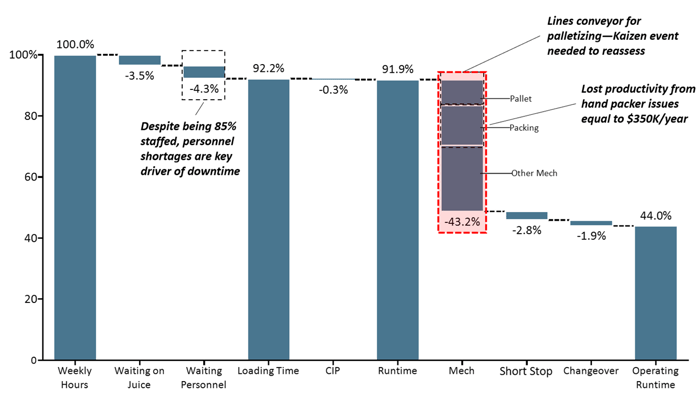Efficiency was down across the board, with the performance of most plants below 50%. Staffing shortages, compounded by rampant turnover, led to insufficient maintenance support and unstaffed lines. With more than half of all downtime due to mechanical stops, along with a lack of focus on continuous improvement, there was an urgent need for process improvement and standardization. Furthermore, company-wide improvements in both maintenance and staffing had fallen flat in the past due to plants operating independently, with few attempts to share best practices and minimal cross-plant communication.
1. Plant Assessment
We began by conducting plant assessments to understand and analyze current performance and plant utilization. Supported by OEE waterfalls, WP&C could clearly quantify and categorize losses to line efficiency and develop a recovery roadmap. This roadmap included improved maintenance practices, recruiting support, continuous improvement, and supervisor training.
2. Maintenance
We built out preventative maintenance plans across all key lines, pinpointed critical spare parts, and created plans to stock and replenish parts inventory.
3. Staffing
We implemented and leveraged a new applicant tracking system to accelerate job posting and hiring, executed hiring process improvements to improve applicant engagement, and created a staffing playbook to incorporate metrics into the recruiting team’s strategic decision making.
4. Continuous Improvement
We focused on line-level improvement activities and leveraged kaizens to create improvement plans for immediate implementation that balanced benefit and effort to quickly reduce downtime and improve throughput.
5. Supervision
Using WP&Cs proven Supervisory Leadership Model, we conducted training sessions with front-line leaders to provide a framework for taking action and driving continuous improvement.
WP&C engaged managers and supervisors across plants and functions to improve efficiency and reduce waste by:
- Regularly ascertaining key drivers of downtime and executing kaizen events to demonstrate key skills and develop line specific roadmaps to improve efficiency
- Verifying preventative maintenance tasks are scheduled and completed at regular intervals
- Utilizing an applicant tracking system to set baseline hiring metrics, track data, and use it for strategic staffing decisions
- Maintaining a continuous improvement cadence to track and drive root causes to completion
- Establishing and maintaining a continuous improvement training program to drive operational excellence

We split downtime causes into several categories to measure what was causing the bulk of downtime. These OEE waterfalls allowed us to pinpoint our focus for maximum benefit.


